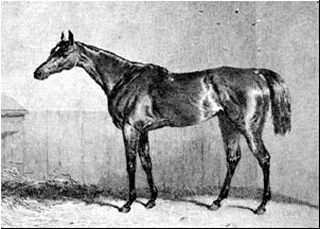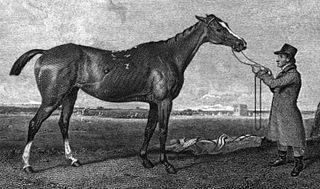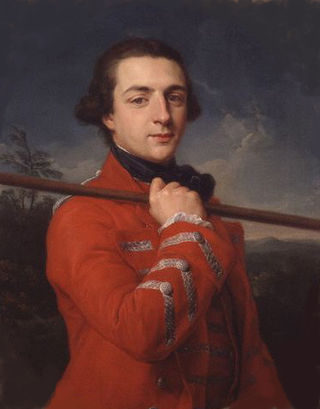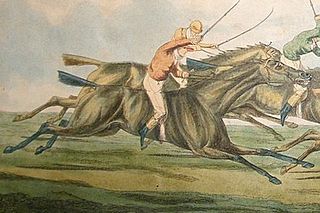Corinne was a British Thoroughbred racehorse and broodmare, which in 1818 became the second filly to win both the 1000 Guineas at Newmarket Racecourse and the Oaks at Epsom Downs Racecourse. In a racing career which lasted from April 1818 until August 1820 she ran eighteen times and won eight races.
Zinc (1820–1840) was a British Thoroughbred racehorse and broodmare, which in 1818 became the third filly to win both the 1000 Guineas at Newmarket Racecourse and the Oaks at Epsom Downs Racecourse. As a three-year-old in 1823 she won three of her five starts, with her defeats coming against the classic-winning colts Nicolo and Emilius. She won both her races in 1824 but failed to win as a five-year-old in 1825 and was retired from racing.
Zeal was a British Thoroughbred racehorse and broodmare, which won the eighth running of the classic 1000 Guineas. As a three-year-old in 1821 won she won her first three races at Newmarket Racecourse including the 1000 Guineas but then finished fourth in The Oaks. As a four-year-old she walked over in the valuable Port Stakes but was beaten in her only other race. She later had a successful career as a broodmare.
Catgut was a British Thoroughbred racehorse and broodmare who won the classic 1000 Guineas at Newmarket in 1819. The Guineas was the filly's only competitive win in six races, her other victory coming when she was allowed to walk over on her racecourse debut.
Whizgig (1819–1840) was a British Thoroughbred racehorse and broodmare who won the classic 1000 Guineas at Newmarket in 1822. In a racing career which lasted from April 1822 until May 1824 she ran fourteen times and won seven races. Unraced as a two-year-old, Whizgig won six of her seven races in 1822, her only defeat coming in the Oaks Stakes. She remained in training for a further two seasons, but was less successful, winning only one more race. She later became a successful broodmare.
Tontine was a British Thoroughbred racehorse and broodmare who won the classic 1000 Guineas at Newmarket in 1825. When the other horses entered in the race were withdrawn, Tontine became the only horse to win a classic by walkover. In a racing career which lasted from April 1825 until April 1826 she ran eight times and won three races. Unlike many of her near relatives, Tontine made no impact as a broodmare.
Problem was a British Thoroughbred racehorse and broodmare who won the classic 1000 Guineas at Newmarket in 1826. After winning the classic on her first appearance on a racecourse, Problem was beaten on her next five starts before returning to form to win two match races at Newmarket 1827. After her retirement, Problem became a successful and influential broodmare.
Music was a British Thoroughbred racehorse and broodmare who won the classic Oaks Stakes at Epsom Downs Racecourse in 1813. Music's success in the Guineas was the only win in a seven race career and gave her owner George FitzRoy, 4th Duke of Grafton the first of twenty classic wins. Music was sold and exported to Ireland at the end of her three-year-old season.
Pastille was a British Thoroughbred racehorse and broodmare who won two British Classic Races. In a career which lasted from April 1822 until November 1824, she won eight of her thirteen races and was placed second or third in the other five. On her second racecourse appearance in she became the first filly to win the 2000 Guineas at Newmarket and went on to win the Oaks Stakes at Epsom Downs Racecourse a month later. She won once as a four-year-old in 1823 and was unbeaten in three starts in 1824. After her retirement from racing she had some success as a broodmare.

Oxygen was a British Thoroughbred racehorse and broodmare who won the classic Oaks Stakes at Epsom Downs Racecourse in 1831. In a racing career which lasted from July 1830 until April 1833 she won eight of her fifteen races and finished second on five occasions. Oxygen's Oaks was the last of twenty classic wins for her owner George FitzRoy, 4th Duke of Grafton.

Turquoise (1825–1846) was a British Thoroughbred racehorse and broodmare who won the classic Oaks Stakes at Epsom Downs Racecourse in 1828. In a racing career which lasted from April 1828 until April 1830 she ran eighteen times, winning eleven races and finishing second on five occasions. As a three-year-old in 1828 she failed to attract a bid after winning a claiming race at Newmarket but then created an upset by winning the Oaks at odds of 25/1. She went on to prove herself a leading stayer, winning three more races before the end of the season. In 1829 she won five more races including three walkovers when no horses appeared to challenge her. She was retired after a single unsuccessful run in 1830.
The Filly by Selim was an unnamed British Thoroughbred racehorse who won the second running of the classic 1000 Guineas at Newmarket Racecourse in 1815. The filly was killed after falling in the Oaks Stakes, her only other race.

Rhoda was a British Thoroughbred racehorse and broodmare who won the third running of the classic 1000 Guineas at Newmarket Racecourse in 1816 and was the most successful racehorse in Britain two years later. Rhoda was one of the most active of all British classic winners, running in at least forty-five contests between 1816 and 1820 and winning twenty-one times. Her actual number of competitive races was even higher as many of her later races were run in multiple heats, with the prize going to the first horse to win twice. She won the 1000 Guineas on her second appearance but did not run as a three-year-old after finishing unplaced in the Oaks Stakes. Rhoda won three races in 1817, ten in 1818, four in 1819 and two in 1820.

Charlotte West was a British Thoroughbred racehorse and broodmare who won the seventeenth running of the classic 1000 Guineas at Newmarket Racecourse in 1830. In a racing career which lasted from April 1830 until May 1831 the filly ran seven times and won four races. After winning the 1000 Guineas on her second racecourse appearance, Charlotte West was beaten when favourite for the Oaks Stakes but returned to win races at Ascot and Newmarket before the end of the year. She failed to reproduce her best form in 1831 and was retired from racing.

Cobweb (1821–1848) was an undefeated British Thoroughbred racehorse and who won two British Classic Races as a three-year-old and went on to become a highly successful broodmare. Cobweb's racing career consisted of three competitive races in the early part of 1824. After winning on her debut she claimed a second prize when her opponents were withdrawn by their owners. She then won the 1000 Guineas at Newmarket Racecourse and the Oaks Stakes at Epsom Downs Racecourse before being retired to stud.
Maid of Orleans (1806–1825) was a British Thoroughbred racehorse and broodmare who won the classic Oaks Stakes at Epsom Downs Racecourse in 1809. Unraced as a two-year-old, Maid of Orleans won her first race at Newmarket in April 1809 and then won the Oaks as a 16/1 outsider, beating her more fancied stable companion. The filly won only one of her remaining seven races, and was retired from racing at the end of 1810.

Prunella was a British Thoroughbred racehorse. Raced from 1791 to 1794, she won three races including a Sweepstakes of 200 guineas each at Newmarket. She was retired to stud and became an influential broodmare, foaling Epsom Derby winner Pope and Epsom Oaks winner Pelisse. Her daughters also went on to become top broodmares in their own right. She was owned by Augustus FitzRoy, 3rd Duke of Grafton.

Pope Joan (1809–1830) was a British Thoroughbred racehorse. She won four of her eight starts before being retired to stud, where she became a successful broodmare. She foaled 1000 Guineas winner Tontine, 2000 Guineas winner Turcoman and Epsom Oaks winner Turquoise. Pope Joan was bred by Augustus FitzRoy, 3rd Duke of Grafton and after his death was owned by his son George FitzRoy, 4th Duke of Grafton.

Penelope (1798–1824) was a British Thoroughbred racehorse. She won sixteen of her twenty-four races, including two Oatlands Stakes, the Jockey-Club Plate and she beat Oaks and Derby winner Eleanor. She was bred and owned by Augustus FitzRoy, 3rd Duke of Grafton. After retiring from racing she became an influential broodmare, foaling Derby winners Whalebone and Whisker and 1000 Guineas winner Whizgig.

Pindarrie was a British Thoroughbred racehorse. He raced five times and won the Riddlesworth Stakes and 2000 Guineas Stakes. He was owned by George FitzRoy, 4th Duke of Grafton, and trained by Robert Robson. He only raced in 1820 and was then sent to India.









